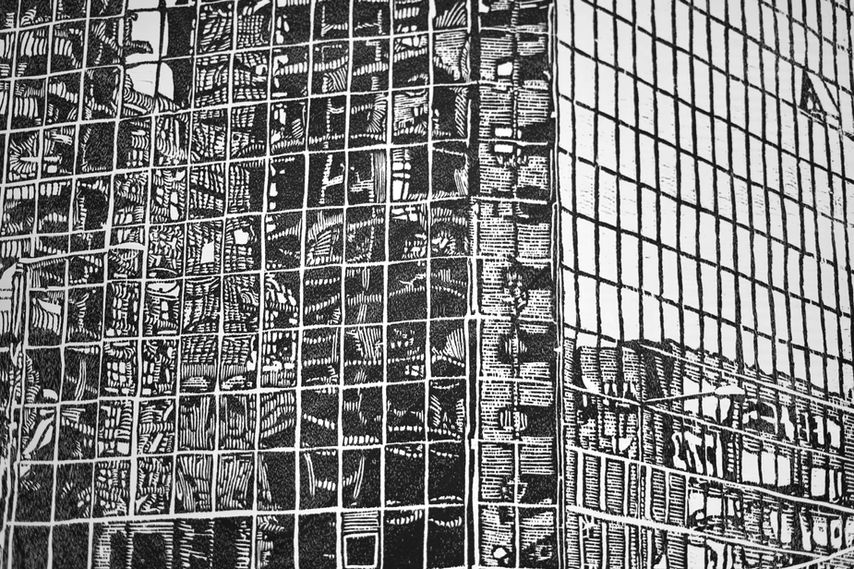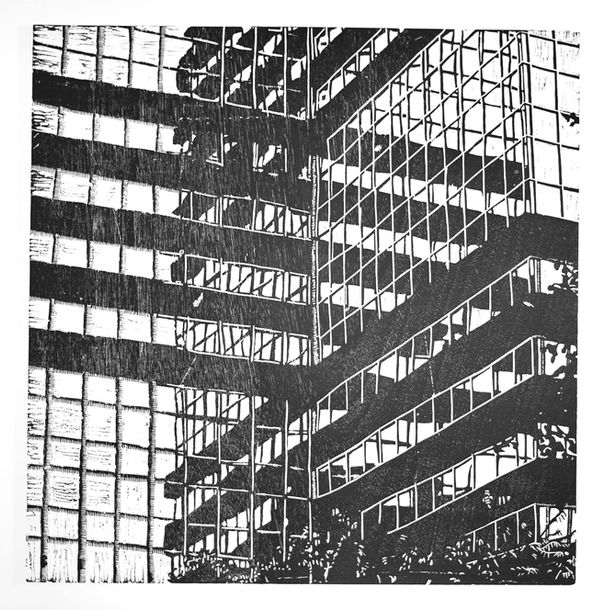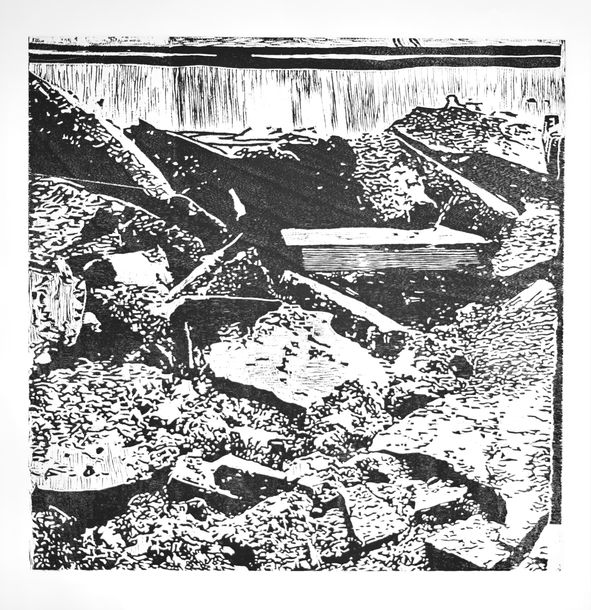Under Construction
Artist:
Nov
2022
Northern Gallery
Curator: Leann Wolf
על ידי התבוננות במרחב העירוני יעל פסמניק עוסקת בשבר שנוצר במציאות חיינו בזמן הסגרים. בשנתיים האחרונות השתנו הגדרות המרחב שלנו, מגבולות המרחב המותר והאסור, דרך מסלול ההגעה או אי ההגעה לעבודה, ובעיקר המרחבים בהם נפגשנו עם אנשים. פסמניק הביטה באובייקטים הנדמים מובנים מאליהם בנוף העירוני; גורדי שחקים, מדרגות, מנופים ומדרכות, וחשפה באמצעותם את התפרקות המציאות כפי שהכרנו אותה, שתוצאותיה ממשיכות להדהד וללוות אותנו גם היום.
במרץ 2021, במהלך הסגר השלישי, החלה פסמניק לעבוד על סדרת ההדפסים המוצגת בתערוכה. מסלול ההליכה שלה כבר התקבע, מהבית אל הסטודיו, מהסטודיו אל העבודה וחזרה אל הבית, מסלול שנתחם בין הערים תל אביב לרמת גן. הרחובות נותרו ריקים מאדם, כמעט סטטיים, ונקודת מבטה השתנתה. הרחוב היה שקט, הכבישים לא היו עמוסים במכוניות ולא היה צורך לתמרן במדרכות מלאות באנשים. מה שאפשר לפסמניק לראות דברים שלא ניתן היה להתבונן בהם עם המולת הרחוב היומיומית. מחד, מבטה תיעד את ההליכה הבודדת בעיר, את הנמצא בקו העיניים, עמוד מודעות שיצא מכלל שימוש, כניסה לחניון, כביש שבור, וגרם מדרגות גלמוד. מאידך, מבטה הופנה כלפי מעלה, אל גורדי השחקים שהקיפו אותה, אשר גילו נופים חדשים שנוצרו בהשתקפויות שלהם. בניינים נמסים ומעוותים, גרידים מרובעים הכוללים צורות משונות ועקומות, שלפעמים לא ניתן לזהות את מקורן, ועגורנים מרקדים ביניהם.
פסמניק צילמה את מסלול ההליכה שלה, היא המירה את הצילומים לכדי רישומים אותם הגדילה והעתיקה לבלוקי עץ, ובעדינות מרובה גרעה אותם לכדי הגלופות שיצרו את ההדפסים. עבודה עמלנית ומדויקת השואפת לייצר שליטה על חומר טבעי, תוך כדי הבנה שהשליטה אינה לגמרי אפשרית. כיוון הסיבים, חורים, והתבקעויות של העץ, אופפים את המרחב העירוני שמוצג בהדפסים. מרחב שבדרך כלל נשלט בידי כבישי אספלט, מדרכות בטון ובניינים עשויים זכוכית ופלדה, מוצג כאן כמרחב שכמעט ומתמזג עם העץ.
עבודותיה של פסמניק לוכדות את הסביבה העירונית בעת שננטשה על ידי האדם, בניסיון לשקף את תחושת הערעור ואיבוד האחיזה במציאות. אלו רגעים חטופים של מבט שצולמו באופן מיידי וללא תכנון מראש, אירועים יומיומיים שכביכול אינם ראויים לציון, אך גילו בתוכם רגע של אותה מציאות מורכבת וכאוטית בריקנותה. ניתן אף לראות בעבודות את החוויה של לחיות באזור ביניים, בין התפרקותו של המרחב לבנייתו מחדש.
טקסט: ליאן וולף
Through observations of the urban space, Yael Pasmanik addresses the fracture created in our lives during the lockdowns. In the last two years the definitions of our space have changed, from the boundaries of the permitted and forbidden spaces to the routes we took or didn't take to work, and especially the places where we met with people. Pasmanik looked at seemingly apparent objects in the urban landscape; Skyscrapers, stairs, cranes, and sidewalks, and through them revealed the dismantling of reality as we knew it, whose results continue to resonate and accompany us even today.
In March 2021, during the third lockdown, Pasmanik began working on the series of prints presented in the exhibition. Her walking route has already settled, from her home to the studio, from the studio to work, and back home, a route bounded between Tel Aviv and Ramat Gan. As the streets remained empty, almost static, her perspective changed. There were no cars on the roads, no need to maneuver through crowded sidewalks, the streets were quiet. This allowed Pasmanik to see things that could not be observed in the daily rowdiness of the streets. On the one hand, her gaze recorded the solitary walk in the city, a disused bulletin board, an entrance to a parking lot, a broken road, and a lonesome staircase. On the other hand, her gaze was directed upwards, toward the skyscrapers that surrounded her, revealing new landscapes created in their reflections. Melting and distorted buildings, square grids that include strange and crooked shapes, whose origins are sometimes unrecognizable, and cranes dancing between them.
Pasmanik photographed her walking route, she converted the photos into drawings, enlarged and copied them onto wooden blocks, then very gently carved them into the plates that created the prints. A laborious and precise process that strives to control a natural material, while recognizing that control is not entirely possible. The direction of the fibers, holes, and fissures of the wood surround the urban space depicted in the prints. A space usually dominated by asphalt roads, concrete sidewalks, and buildings made from glass and steel, is presented here as a space that almost merges with the wood.
Pasmanik's works portray the urban environment as it was abandoned, in an attempt to reflect the feeling of instability and loss of grip on reality. These are quick glances photographed without prior planning, everyday events that are supposedly unremarkable but reveal moments of that complex reality, chaotic in its emptiness. It seems the prints convey a sense of living in a liminal zone, between the disintegration of the space and its reconstruction.
Text by Leann Wolf









